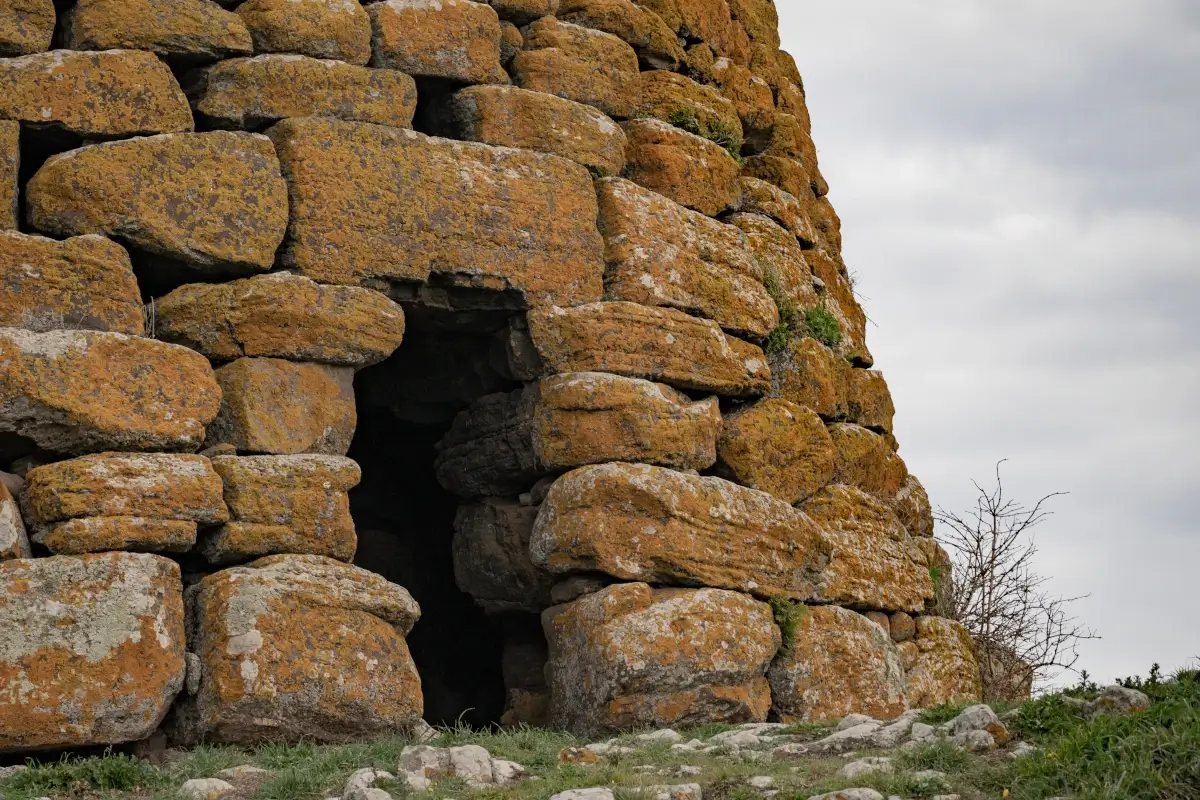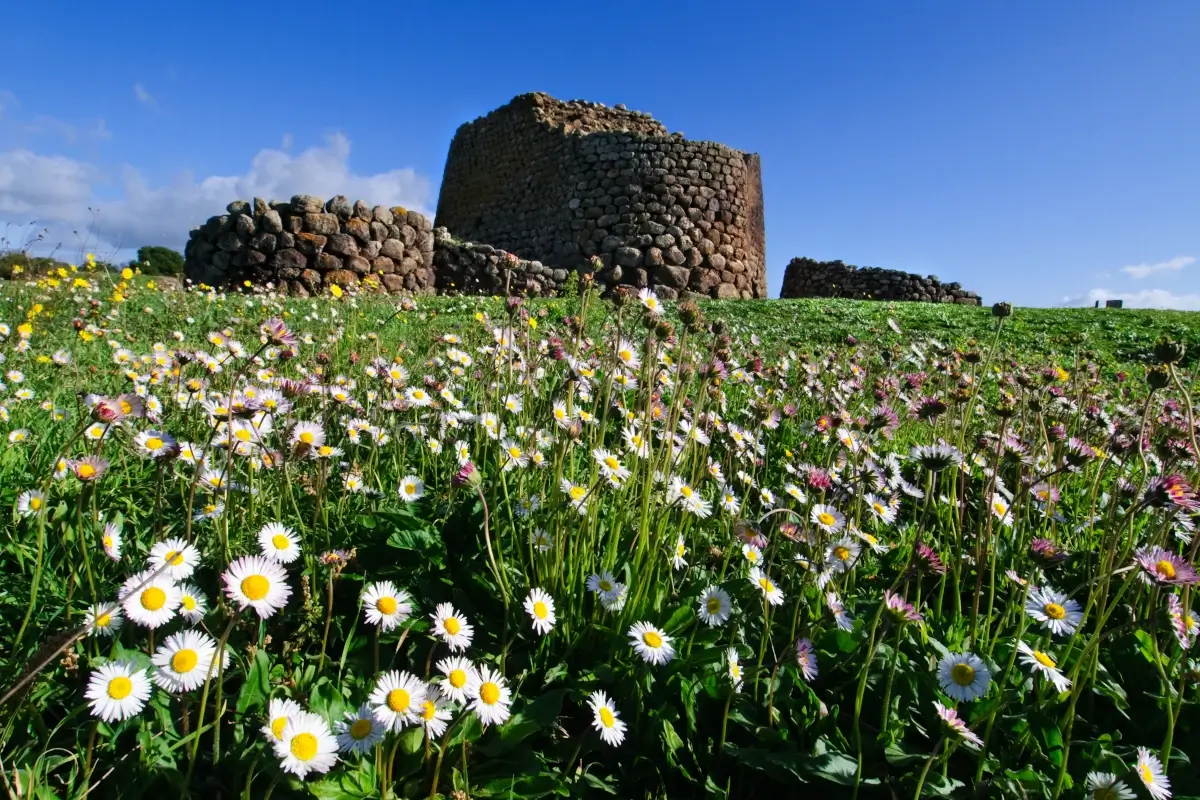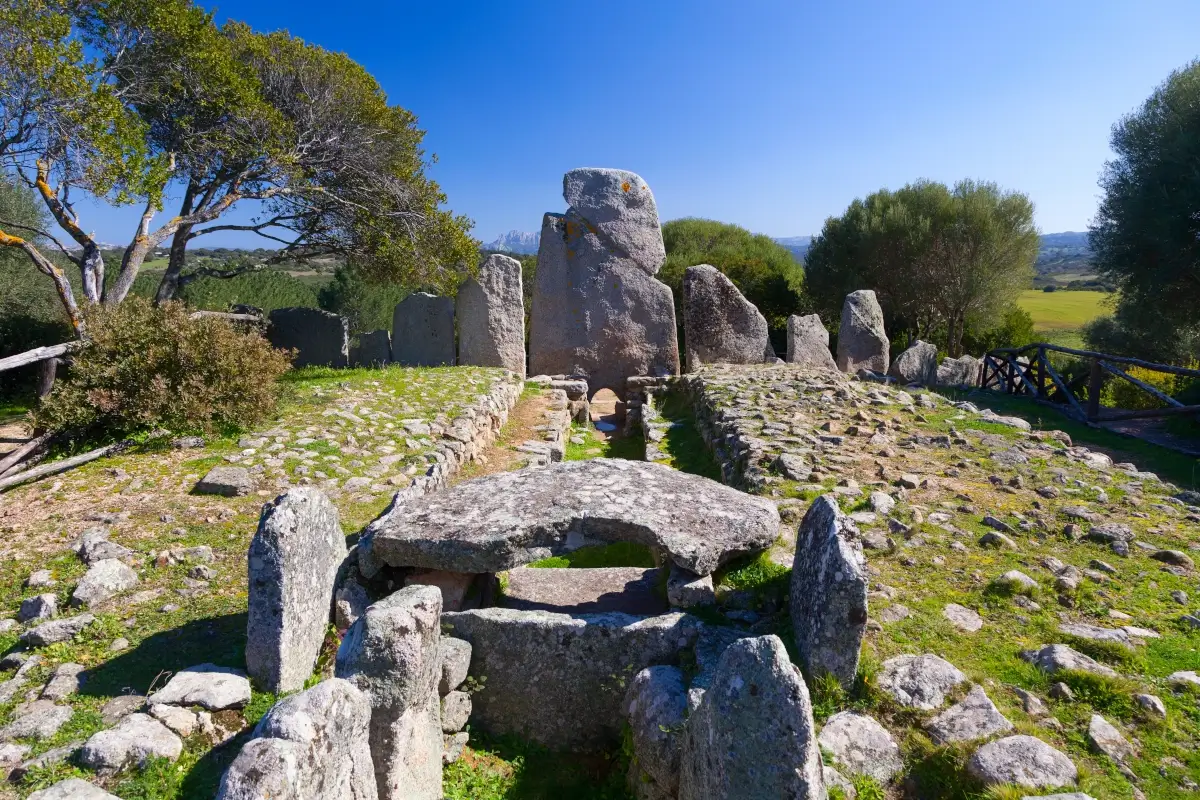PREHISTORY
Long before the Emerald Coast became synonymous with luxury and glamour, it was home to ancient civilizations that left their mark on the region’s rugged landscapes. The area’s prehistory dates back to the Nuragic civilization, which thrived in Sardinia from around 1800 to 500 BCE. This mysterious culture is renowned for its construction of nuraghi, megalithic stone towers that served as fortresses, dwellings, or ceremonial sites. While the Emerald Coast is known today for its beaches and resorts, traces of this ancient past can still be found in the surrounding countryside.
Archaeological sites like the Nuraghe Albucciu, located near the town of Arzachena, offer a fascinating glimpse into the life of Sardinia’s earliest inhabitants. This nuraghe, with its unique elliptical shape, is thought to have been both a defensive structure and a place of community gatherings. Nearby, the Giants’ Tombs, massive burial sites built with towering slabs of stone, further showcase the ingenuity and spiritual beliefs of the Nuragic people. Complementing the nuraghi are the Giants’ Tombs, massive stone burial sites that reflect the spiritual and ritualistic practices of the Nuragic people. These monuments, such as the Coddu Vecchiu Giants’ Tomb, are a fascinating window into the beliefs and customs of Sardinia’s prehistoric communities.
The Emerald Coast’s prehistoric roots extend beyond these monuments. The lush hills and valleys surrounding the coastline were likely home to small agricultural communities that thrived off the land’s natural resources. These early settlers shaped the region’s identity long before it became the glamorous destination we know today.
Exploring the prehistoric sites of the Emerald Coast is a journey back in time, revealing the deep and ancient history that lies beneath its modern allure. For those seeking to connect with Sardinia’s past, these archaeological treasures offer a profound and enriching experience.
HISTORY
The Emerald Coast, or Costa Smeralda, is not only a modern haven of luxury and beauty but also a region steeped in history that dates back thousands of years. Its story begins long before it became a glamorous destination, with traces of ancient civilizations that have left their mark on this stunning coastline.
As time passed, the Emerald Coast became a crossroads for Mediterranean civilizations. The Phoenicians, known for their seafaring prowess, established trade routes along the Sardinian coast, introducing goods, ideas, and cultural influences. They were followed by the Carthaginians, who further developed Sardinia as a hub for commerce and agriculture. Later, the Romans took control of the island, integrating it into their vast empire. Sardinia’s strategic location made it an important asset for trade and military operations, and the Romans left their mark through the construction of roads, aqueducts, and ports. While the rugged terrain of the Emerald Coast itself remained sparsely populated, its secluded coves and natural harbors became vital for maritime activities.
During the medieval period, Sardinia, including the Emerald Coast, experienced a series of power shifts as it came under the control of various ruling entities, including the Byzantines, the Pisans, and later the Aragonese. This era was marked by the rise of fortified towns and villages further inland, as coastal areas were frequently targeted by pirates and invaders. The nearby town of Arzachena, with its strategic position close to the coast, became a key settlement during this time. Its surrounding hills provided natural protection, while its proximity to the sea allowed for trade and communication with other parts of the island.
The medieval period also saw the development of Sardinia’s unique cultural identity, blending influences from its rulers with local traditions. This rich heritage is reflected in the architecture, language, and customs of the region, which have been preserved and celebrated over the centuries.
The Emerald Coast as we know it today began to take shape in the 1960s when it was “discovered” by Prince Karim Aga Khan IV. Captivated by the area’s untouched beauty, the prince envisioned transforming Costa Smeralda into a world-class luxury destination. Together with a team of architects, he meticulously planned the development of the region, ensuring that its natural charm and ecological integrity were preserved. The result was a harmonious blend of traditional Mediterranean architecture and modern elegance. The town of Porto Cervo became the centerpiece of this transformation. Designed to resemble a traditional fishing village, Porto Cervo features winding streets, whitewashed buildings, and a picturesque harbor filled with luxury yachts. It quickly became a playground for the world’s elite, attracting celebrities, royalty, and discerning travelers. High-end resorts, exclusive beach clubs, and designer boutiques followed, solidifying Costa Smeralda’s reputation as a premier destination for luxury and leisure.
Today, the Emerald Coast is celebrated not only for its modern glamour but also for its rich historical tapestry. Visitors can explore ancient sites such as the Nuraghe Albucciu and the Giants’ Tombs, which offer a fascinating glimpse into Sardinia’s prehistoric past. The medieval charm of nearby towns like Arzachena adds another layer of intrigue, while the modern elegance of Porto Cervo showcases the region’s remarkable transformation.
Beyond its historical and cultural significance, Costa Smeralda remains a natural paradise. Its pristine beaches, such as Liscia Ruja and Spiaggia del Principe, are among the most beautiful in the Mediterranean. The surrounding hills and granite cliffs provide opportunities for hiking and exploration, while the crystal-clear waters are perfect for sailing, snorkeling, and diving.
ARCHAEOLOGY
One of the most significant archaeological highlights of the Emerald Coast is its connection to the Nuragic civilization, which flourished in Sardinia between 1800 and 500 BCE. This ancient culture is renowned for its nuraghi, mysterious megalithic stone towers that are unique to Sardinia. These structures, believed to have served as fortifications, communal dwellings, or ceremonial sites, are scattered across the island, with notable examples near the Emerald Coast. The Nuraghe Albucciu, located in Arzachena, is one of the most accessible sites in the area, offering visitors a glimpse into the ingenuity and lifestyle of the Nuragic people. Its unique elliptical shape and strategic location make it a fascinating stop for archaeology lovers.
Another remarkable feature of Sardinia’s prehistoric past is the Giants’ Tombs, massive megalithic burial sites that reflect the spiritual and ritualistic practices of the Nuragic civilization. The Coddu Vecchiu Giants’ Tomb, also near Arzachena, is one of the best-preserved examples in the region. These monumental structures, made from towering slabs of stone, are thought to have been communal burial sites and hold a deep connection to the island’s ancient mythology and beliefs.
As a strategic point in the Mediterranean, the Emerald Coast was influenced by several ancient civilizations, including the Phoenicians and later the Romans. While the coastline itself was sparsely populated during these periods, nearby areas served as important hubs for trade and communication. Roman influence is evident in the ruins of roads, aqueducts, and settlements scattered throughout Sardinia, some of which can be explored on day trips from the Emerald Coast. These remnants provide insight into the island’s role as a vital part of the Roman Empire.
The waters surrounding the Emerald Coast are also rich in archaeological significance. Submerged shipwrecks and ancient artifacts lie beneath the turquoise waves, offering a glimpse into Sardinia’s maritime history. For adventurous travelers, diving excursions guided by professional archaeologists allow for the exploration of these underwater treasures, making it a unique way to connect with the past.
The archaeological sites of the Emerald Coast offer more than just a window into the past—they provide a deep connection to the island’s cultural identity and its ancient inhabitants. Whether you’re exploring the towering nuraghi, standing in awe before the Giants’ Tombs, or diving into the mysteries of the Mediterranean’s underwater relics, the archaeology of the Emerald Coast is an unforgettable experience that adds a layer of historical depth to this stunning destination.




